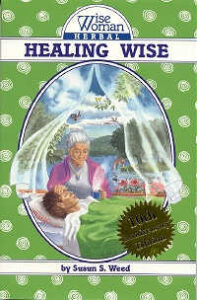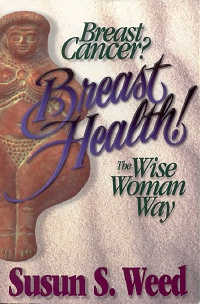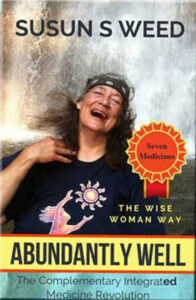Hi Susun,
Do you have any tips for managing fibromyalgia naturally? Thanks, and blessings for the New Year.
Susun’s response:
Here is the Wise Woman Way approach to Fibromyalgia:
Step 0. Do Nothing
- Women dealing with fibromyalgia have less pain if they sleep in a completely dark room. If that’s impossible, wear a sleep mask.
Step 1. Collect information
Neither cause nor cure for fibromyalgia is known. It is not a disease but a range of symptoms characterized by chronic, widespread pain on both sides of the body, above and below the waist. (As one of my apprentices put it: “But I don’t hurt in all those places at once. The pain moves around. I never know where it will be next.”) Some women have a low fever in addition to pain. More than half of those with fibromyalgia also suffer from headaches, endometriosis, and/or irritable bowel syndrome.
The symptoms of fibromyalgia are quite variable, making diagnosis difficult. (Orthodox diagnosis is predicated on finding soreness at specific trigger points.) Fibromyalgia mimics aspects of multiple sclerosis, Parkinson’s disease, arthritis, hepatitis C, hypothyroidism, lupus, polymyalgia rheumatica, and early dementia. Many women with fibromyalgia are told their distress is “all in your mind.”
It isn’t in your mind (alone). Menopause can leave you feeling like you’ve been beaten on. Muscles respond to hormonal changes by feeling sore and cranky. Sleep loss can make you ache. (Non-restorative sleep is a hallmark of fibromyalgia.) Lack of calcium (and other minerals) can make your bones ache. Whether you are dealing with these challenges, or the greater problem of fibromyalgia, why not give Wise Woman Ways a try? The remedies listed here have been remarkably successful in helping many women.
People with fibromyalgia aren’t just sensitive to pain; they also find loud noises, strong odors, and bright lights aversive. – Daniel Clauw, MD, Director, Chronic Pain and Fatigue Research Center, Georgetown University
Step 2. Engage the energy
- Having a support group is one of the strongest factors in keeping fibromyalgia under control.
- Homeopathic Arnica is an amazing remedy for sore and aching muscles. Daily use of homeopathic Rhus toxicodendron reduced pain by 25 percent in those with fibromylagia.
- Make a list of things you are sore (upset, angry) about. Where do these things live in your body? With the help of an experienced bodyworker, loosen those places. Women with fibromyalgia are very likely to be survivors of trauma (sexual or domestic violence, alcoholism).
- Go back to your Mother. Float in the ocean. Lie belly down on the earth. Naked. Let her ease you. Let her heal you.
- Listen to a relaxation tape. Have someone show you how to do the yoga position called the “Corpse Pose.” Learn how to bring yourself to a deep state of inner quiet and peaceful mind.
- Hypnotherapy can help you gain some degree of mental control over their symptoms. Cognitive behavior therapy is also helpful.
Step 3. Nourish and tonify
- Consistent use of nourishing herbal infusions, especially comfrey leaf and stinging nettle, in place of coffee, tea, and sodas is the single most effective thing I know for mitigating and overcoming fibromyalgia.
- Gentle exercise—walks, yoga or tai chi practices—keeps muscles from weakening and becoming more painful. Experts suggest starting with as little as three minutes a day, and gradually building to at least four sessions of five minutes each per day. Persist; the reward is worth it.
- Regular consumption of yogurt also proves very helpful for those with fibromyalgia. Perhaps it is due to yogurt’s ability to strengthen and nourish immunity; some suspect fibromyalgia is a result of immune system malfunction.
- Magnesium is a critical nutrient for preventing pain in muscles and connective tissues. Legumes, whole grains, leafy greens and nourishing herbal infusions—like nettle and oatstraw—are the best sources.
- Moxibustion is also known as needleless acupuncture. Safe and easy to do at home by yourself, moxibustion gives fast relief from sore joints and aching muscles. It not only relieves pain but tonifies, decreasing future pain and gradually effecting a “cure.” You can buy a moxa “cigar” at an Oriental pharmacy or health food store. Bring the glowing end of the moxa (after lighting it) near the painful area and move it around in small slow spirals until the heat becomes too intense. (This may take a few minutes or many.) Pain relief is usually immediate and often lasts for twelve or more hours.
Step 4. Stimulate/Sedate
- Tinctures of willow bark or spirea (1-2 dropperfuls/1-2 ml is a dose) are highly recommeded as important green allies by women dealing with fibromyalgia.
- St. Joan’s wort tincture—not capsules, not the tea—is a powerful ally for women with fibromyalgia. It is one of the best muscle relaxers I have ever used. A 25-30 drop dose not only stops but also prevents muscle aches. I have used it as frequently as every twenty minutes (for ten doses) when the occasion has necessitated it. St. Joan’s wort prevents soreness when taken after exercise; and even better if taken before. I take a dose every hour while on an airplane to prevent muscle aches and jetlag.
- Regular massage from an experienced therapist stimulates the circulation of blood and energy, relieves pain, reduces fatigue, and eases stiffness. Avoid deep tissue massage; it increases pain. Light strokes and gentle myofascial releases are more helpful. Chiropractic manipulations are of little benefit.
- Massage with heated stones and other heat treatments works wonders for some women. For others, cold treatments work better (but not too cold, and not for too long either, please).
- Ginger compresses, hot or cold, stir up circulation and mobilize the body’s own healing agents to take action and ease your pain. I grate several ounces of fresh ginger into simmering water, cook it gently for ten minutes, then soak a cloth in the liquid and use that as an application to the sore area.
- The National Institutes of Health lists fibromyalgia as one of the few conditions that acupuncture can relieve.
- If lying down sleep makes the pain worse, slip into something relaxing: valerian, skullcap, or St. Joan’s wort tinctures, up to a dropperful/1 ml of any one, repeated twice if needed.
Step 5a. Use supplements
- A study found little benefit from those with fibromyalgia taking either SAM-e or 5-HTP (5-hydroxytryptophan—a precursor to serotonin). Do not use 5-HTP if you are taking St. Joan’s/John’s wort.
- Lack of sleep can quickly aggravate symptoms of fibromyalgia. (See Step 0.) If sleep confounds you, melatonin at bedtime, the lowest dose you can get, may help.
Step 5b. Use drugs
- Essential oil of lavender was recommended by several women who have dealt with fibromyalgia for many years. Dilute with jojoba or olive oil and use as a rub.
- Orthodox treatment of fibromyalgia relies heavily on drugs, primarily antispasmodics, antidepressants and muscle-relaxers. But Celebrex, Vioxx, Valteran, amitriptyline (Elavil), fluoxetine (Prozac), vanlafaxine (Effecor), trazadone (Desyrel), alprazolam (Xanax), and cyclobenzaprine (Flexeril) can adversely affect the liver and disrupt the immune system.
- Nonsteroidal anti-inflammatory drugs such as ibuprofen do not reduce fibromyalgia pain for most women.
- Tramadol (Ultram) is a drug which addresses borh the altered brain chemicals and the pain signals of those with fibromyalgia.
Step 6. Break and enter
- Beware of invasive diagnostic tests. Many women report enduring endless rounds of tests trying to put a name to their pains with no success and at the price of physical, mental, and emotional distress.
- Injections of lidocaine, a drug that temporarily numbs nerves, are effective in relieving fibromyalgia pain for some women. Injections of capsaicin (from cayenne) relieve pain by destroying nerve endings.
Green blessings, Susun Weed
photos: Wise Woman Spiral © iStockphoto.com / Chuck Spidell | Meditation © Melissa Harris












0 Comments